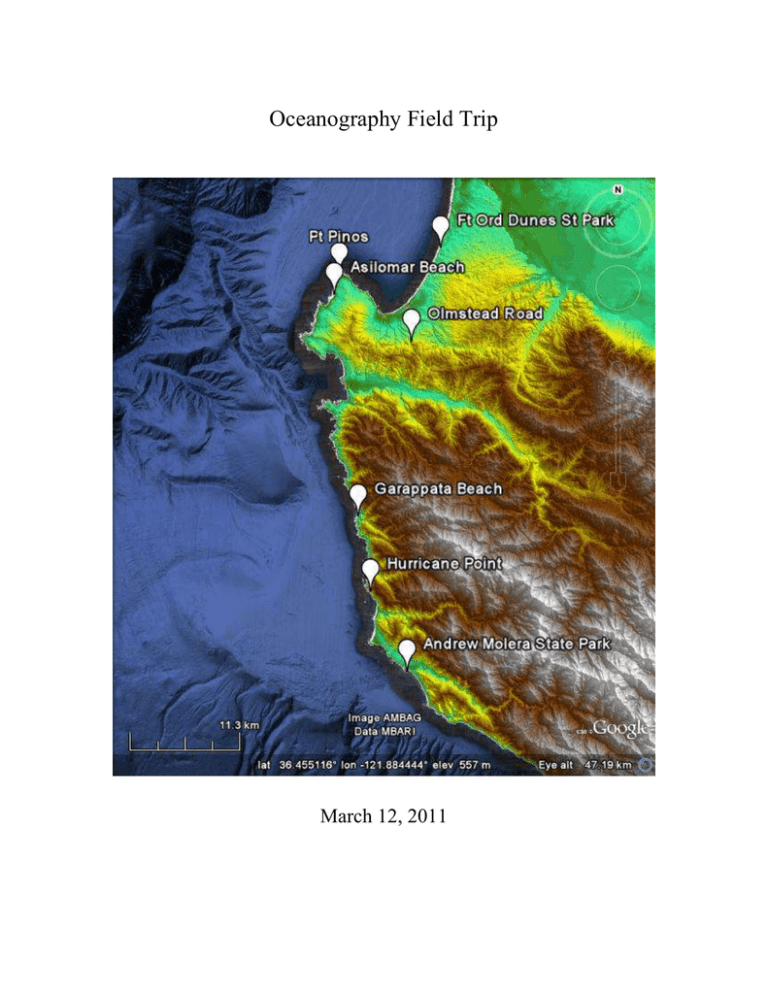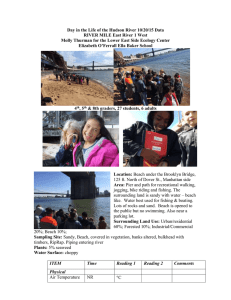Field Trip Guide
advertisement

Oceanography Field Trip March 12, 2011 Introduction Exploring sediments and rocks of the seafloor is one theme of the on-land field trip. As we travel from stop to stop imagine yourself traveling around on the seafloor. We’ll be able to visit many of the seafloor areas we’ve talked about in class, including a mid-ocean ridge and the deep sea floor of the abyssal plain. Another theme of the field trip is the coastal processes of dunes and beaches, and the contrasts between the rocky emergent coastline of Big Sur and the smooth, sandy coastline of a more stable environment like Marina and Ft Ord. The last theme of the weekend field trip is the collection of beach profile data. You will use this field trip guide in an upcoming next Oceanography lab. Monterey Formation on Olmstead Road. The most important thing to notice here is the Monterey Formation Diatomaceous Shale. To the naked eye, this rock looks like mudstone. But if we had powerful microscopes, we could see all of the diatoms that comprise this rock. Since there is very little terrigeneous material in the rock, we know that it was formed far from continents. It was probably formed in the deep oceans of the abyssal plains. What is the evidence that tectonics moved these rocks up to this spot on the hill rather than the sea level dropping to expose these rocks? How did the rocks move from the seafloor to the North American continent? Through tectonic processes. When plates or blocks of rocks converge, the rocks in the middle deform in such a way that they get thicker. Getting thicker means creating mountains and mountain ranges. Imagine continents colliding and mountain ranges forming. Mountaineers at the top of Mt Everest in the Himalayas have found fossils of creatures that lived in the oceans. Ft Ord Dunes State Park Dunes and sandy beach in a rapidly eroding environment that is not rapidly emerging. The dunes here are big and extend for a few miles inland. In fact, we will see evidence of previous episodes of dune formation. Photos from 1997 Look at the photographs to the left. Where is the bus parked in these photos? Use a labeled arrow to show the location of the bus. What is the evidence of rapid erosion of the seacliff in this area? Why do we think this area is not rapidly emerging? What is the evidence for more than one episode of dune formation? What is the evidence that the dune sands are transported by wind? Pt Pinos How does this coastal environment differ from the Marina-Ft Ord area? What is the evidence of erosion here? Do you think it is eroding as fast as the Marina- Ft Ord area? What do you think causes any difference in erosion rate that you might have observed? What are the characteristics of the sand here? How does it compare to the bedrock? Asilomar Beach How does the sand here at Asilomar Beach compare with the sand at Pt Pinos? What are the similarities and differences between this section of the coast and Pt Pinos? Hurricane Point Excellent view of the Big Sur coastline, one of the worlds best examples of an emergent coastline. It just doesn’t get any better than this! The rock here is a marble, which is a metamorphosed limestone. Limestone is deposited in warm shallow seas where coral and tropical fish make it nice to snorkel. Then the limestone gets metamorphosed into marble. What is the difference between a marine terrace and a wave-cut platform? What is all the evidence here for emergence and for erosion along the coastline? Andrew Molera State Park We’ll walk to the mouth of the Big Sur River here and see the results of volcanism and sedimentation at a mid-ocean ridge. Note the pillow basalts and chert. We’ll also note wave refraction as the waves move in towards the beach. Can you find any pink sand? If you can it is composed of garnet that occurs abundantly in rocks found upstream along the Big Sur River. What is the evidence that this group of rocks were deposited near a mid-ocean ridge or on a seamount? What is wave refraction, and where can you see it here? What is the evidence here that waves push sand along the beach in a process called longshore drift? Describe how the interplay between the forces of the ocean waves and the forces of the water flowing out the Big Sur River shape the beach in this area. Garrapata Beach Two main things to see here: the submarine fan turbidites and the San Gregario Fault. The sedimentary rocks here are distal turbidites. That means that they are deposited by turbidity currents, but far out on the submarine fan. Remember these rocks and compare their grain size to the rocks that we’ll see (or have seen) at Pt Lobos. What is the evidence that the turbidites here were deposited far from shore on the continental slope? Also at Garrapata Beach, we’ll also see the San Gregario Fault. The San Gregario Fault is part of the San Andreas Fault system and is one of the fault that separates the Pacific plate from the North American Plate. It is the same kind of fault as the San Andreas Fault. What kind of fault is the San Gregario Fault? How were you able to locate the fault on Garrapata Beach? Where is it? Garrapata Beach Profile Data Please record your beach profile data on this page. Bring these sheets to the next Oceanography lab. Remember to fill in the distance from the benchmark to the sand on your data sheets. See the next page for photographs of all the benchmarks. Please do your profile twice, and fill in the data under the A and B columns. Remember to record negative numbers when going downhill and positive numbers when going uphill (if ever). Northern profile Vertical distance from benchmark to sand, in cm.__ A B 1 2 3 4 5 6 7 8 9 10 11 12 13 14 15 16 17 18 19 20 21 22 23 24 25 26 27 28 29 30 31 32 33 34 New Northern profile Vertical distance from benchmark to sand, in cm.__ A B 1 2 3 4 5 6 7 8 9 10 11 12 13 14 15 16 17 18 19 20 21 22 23 24 25 26 27 28 29 30 31 32 33 34 Central profile Stairs Profile Vertical distance from benchmark to sand, in cm.__ A B 1 2 3 4 5 6 7 8 9 10 11 12 13 14 15 16 17 18 19 20 21 22 23 24 25 26 27 28 29 30 31 32 33 34 Vertical distance from benchmark to sand, in cm.__ A B 1 2 3 4 5 6 7 8 9 10 11 12 13 14 15 16 17 18 19 20 21 22 23 24 25 26 27 28 29 30 31 32 33 34 Southern profile Vertical distance from benchmark to sand, in cm.__ A B 1 2 3 4 5 6 7 8 9 10 11 12 13 14 15 16 17 18 19 20 21 22 23 24 25 26 27 28 29 30 31 32 33 34 Garappata Beach For which profile did you collect data (circle one)? Record the distance from the benchmark to the sand on the table as a negative number. North In the Granite Central In the Granite South Of the Stairs “New” Northern In the Granite Stairs



